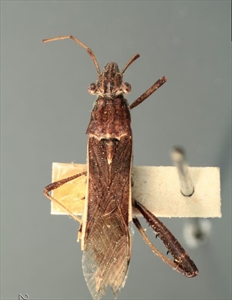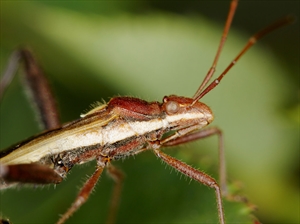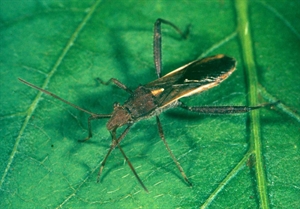Bean bug
Pacific Pests, Pathogens, Weeds & Pesticides - Online edition
Pacific Pests, Pathogens, Weeds & Pesticides
Bean bug (349)
Melanacanthus margineguttatus; the brown bean bug (or small brown bean bug), Melanacanthus scutellaris, is similar. It also attacks pulses. (Note, there is little information on Melanacanthus margineguttatus in the literature, mostly reports are on Melanacanthus scutellaris - a species native to Australia.)
Asia (China), Oceania. It is recorded from Australia, Federated States of Micronesia, Fiji1, Guam, Northern Mariana Islands, and Samoa.
Beans and other legumes - cowpea, mung bean, navy bean, soybean, pigeon pea. Vigna species are favoured hosts. The bean bug is likely to attack legume weeds (e.g. phasey bean and rattle pod); they are also hosts of the small brown bean bug, Melanacanthus scutellaris.
Adults and nymphs suck the pods causing pitting and shrivelling of the seeds. They also damage flowers and buds.
Eggs laid in singly, scattered, and produce nymphs with dull-black heads and ant-like features, except they do not have the narrow waist of ants. The abdomen is pointed, cream, with brown and pink spots. Adults are 10-12 mm long, dull brown, narrow and almost parallel-sided, with a cream stripe along the side (Photo 1). They have prominent eyes. The third section of the hind legs (the longest part) is slightly swollen and has short spines on the inside. The small brown bean bug is similar (Photos 2-4).
A minor pest of food and pasture legumes.
The bean bug may be confused with Riptortus, the large brown bean bug, or pod-sucking bug (see Fact Sheet no. 18). Melanacanthus species have a short spine on each 'shoulder', less so than on Riptortus, and the hind legs are thinner. Look for the ant-like nymphs; those of Melanacanthus species have elongated (not round) abdomens, and six dark spots on the top. Further, the adults of Melanacanthus are slender, and shorter (10-12 mm long) than Riptortus. Identification to species requires expert examination.
Control measures are not normally required for the bean bug, but should they be required follow the recommendations for Riptortus (see Fact Sheet no. 18).
NATURAL ENEMIES
There are no reports of predators or parasitoids attacking Melanancanthus in Pacific island countries. However, the reduviids (assassin bugs), mantids (preying mantids), spiders and wasps that are known to attack Leptoglossus (see Fact Sheet no. 165 ) probably attack Melanacanthus eggs, and prey on nymphs.
CULTURAL CONTROL
Before planting:
- Do not plant crops of beans next to those that are already infested with the bug.
During growth:
- Handpick the insects where crop area is small. Do this in the early morning, as at other times of the day the insects are more likely to take flight.
After harvest
- Collect and burn as much of the crop as possible after harvest.
CHEMICAL CONTROL
If infestations reach levels where chemical control is necessary, use sprays of derris, pyrethrum or chilli (see Fact Sheet no. 56). If a commercial product is needed, use synthetic pyrethroids or malathion. In Australia, there is no product specifically registered for Melanacanthus, but products used against the green vegetable bug are likely to be effective (see Fact Sheet no. 98). Mostly, they are synthetic pyrethroids. But note, these pesticides will also kill the natural enemies.
--------------------
Note, derris (Derris species) contains rotenone, an insecticide, often used as a fish poison; it should be used with caution. The commercial derris insecticide is made from Derris elliptica.
____________________
When using a pesticide, always wear protective clothing and follow the instructions on the product label, such as dosage, timing of application, and pre-harvest interval. Recommendations will vary with the crop and system of cultivation. Expert advice on the most appropriate pesticides to use should always be sought from local agricultural authorities.
AUTHOR Grahame Jackson
1Information from Swaine G (1971) Agricultural Zoology in Fiji. Her Majesty's Stationery Office. London; and DAF (2020) Brown bean bug. Business Queensland. Queensland Government. (https://www.business.qld.gov.au/industries/farms-fishing-forestry/agriculture/crop-growing/pests-field-crops/brown-bean-bug); and from McCaffrey S (2011) (Melanacanthus nr. scutellaris ): PaDIL - http://www.padil.gov.au. Photo 1. Coreoidea species file online. Melanacanthus margineguttatus Distant. The Leverhulme Trust. (http://coreoidea.speciesfile.org/Common/basic/Taxa.aspx?TaxonNameID=1186292). Photos 2&3 The Beatsheet. Insect Pest Management for Australia's Northern Region. (http://thebeatsheet.com.au/resources/insect-identification/podsucking-bugs/bbsm/). Photo 3 Melanacanthus scutellaris (14528939742).jpg Wikimedia Common.(https://commons.wikimedia.org/wiki/File:Melanacanthus_scutellaris_(14528939742).jpg).
Produced with support from the Australian Centre for International Agricultural Research under project PC/2010/090: Strengthening integrated crop management research in the Pacific Islands in support of sustainable intensification of high-value crop production, implemented by the University of Queensland and the Secretariat of the Pacific Community.







